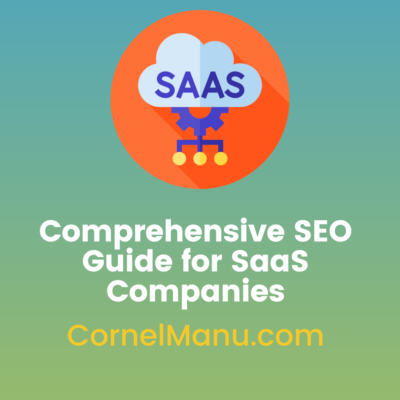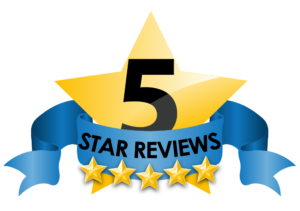I’ve written over 100 books and countless articles. I've helped many 6 figures businesses increase sales by using my text. I have over 100 5-star ratings on Fiverr. I'm a self-published author and a professional writer since 2008.
Comprehensive SEO Guide for SaaS Companies: Driving Business Growth through Organic Search
 I. Introduction to SEO for SaaS Companies
I. Introduction to SEO for SaaS Companies
A. Definition of SEO and its Importance for SaaS Businesses
Search Engine Optimization (SEO) is the process of optimizing a website to improve its visibility and rankings in search engine results. For SaaS companies, SEO plays a crucial role in driving organic traffic, generating leads, and increasing conversions. As the competition in the SaaS industry intensifies, having a robust SEO strategy becomes vital for sustained business growth.
B. Benefits of SEO for SaaS Companies
- Increased Organic Traffic: By targeting relevant keywords and optimizing website elements, SaaS businesses can attract more qualified prospects to their site through organic search.
- Enhanced Brand Visibility: Improved search rankings help SaaS companies gain greater brand exposure, making it easier for potential customers to discover their products or services.
- Cost-Effective Marketing: Compared to paid advertising, SEO offers a cost-effective long-term strategy that can continually generate leads without constant ad spend.
- Improved User Experience: SEO best practices such as better content and user-friendly navigation contribute to an enhanced user experience, leading to higher customer satisfaction and loyalty.
- High-Quality Leads: Organic traffic tends to attract more engaged prospects who are actively seeking solutions, resulting in a higher likelihood of converting them into paying customers.
C. Overview of the Guide This comprehensive SEO guide is tailored specifically for SaaS business owners, particularly small and medium-sized enterprises (SMEs). It will delve into essential aspects of SEO that can help SaaS companies effectively optimize their online presence and drive business growth. The guide covers key elements from keyword research and on-page optimization to creating high-quality content that aligns with user intent.
II. Keyword Research and Strategy
A. Identifying Target Keywords for SaaS Services
- Understanding Your Audience: Conduct thorough research to identify the keywords and phrases that your target audience is using when searching for SaaS solutions. Analyze customer feedback, industry forums, and social media to gain insights into their needs and pain points.
- Focusing on Specific Solutions: Tailor your keyword strategy to highlight the unique features and benefits of your SaaS products or services. Specificity helps attract more relevant traffic and increases the chances of conversion.
B. Analyzing Competitors' Keywords
- Competitor Analysis Tools: Utilize SEO tools to analyze the keywords your competitors are targeting. Identify opportunities where you can outrank them or discover untapped keyword niches.
- Unique Selling Proposition (USP): Differentiate your SaaS offerings by incorporating keywords that emphasize your USP, setting your business apart from the competition.
C. Long-tail Keywords and Their Impact on SaaS SEO
- Understanding Long-tail Keywords: Long-tail keywords are longer and more specific keyword phrases that target niche audiences. They are less competitive and often indicate high user intent.
- Leveraging Long-tail Keywords: Incorporate long-tail keywords into your content and product pages to capture valuable leads with clear purchase intent.
D. Creating a Keyword Strategy and Content Mapping
- Keyword Mapping: Organize keywords into clusters based on relevance and search intent. Map these clusters to specific pages on your website to create a coherent content structure.
- Content Creation: Develop high-quality content around targeted keywords, addressing user queries, and offering valuable insights and solutions.
III. On-Page SEO Optimization
A. Crafting SEO-Friendly Meta Titles and Descriptions
- Meta Titles: Create compelling and concise meta titles that include the primary keyword and accurately represent the content of the page.
- Meta Descriptions: Write engaging meta descriptions that provide a brief summary of the content and encourage users to click through to your website.
B. Optimizing Headers (H1-H6) and Content Structure
- Header Tags: Use header tags (H1-H6) to structure your content and signal the hierarchy of information to search engines.
- Keyword Placement: Include target keywords in headers and subheaders to enhance keyword relevance and improve search ranking.
C. Utilizing Internal Linking to Enhance User Experience
- Internal Link Structure: Incorporate internal links between related pages to improve website navigation and user experience.
- Anchor Text Optimization: Use descriptive anchor text that contains relevant keywords to guide users and search engine crawlers through your site.
D. Implementing Schema Markup for SaaS Products
- Understanding Schema Markup: Schema markup is structured data that helps search engines better understand the content on your website.
- Product Schema: Implement schema markup specific to SaaS products, such as product features, pricing, and customer reviews, to enhance search visibility and click-through rates.
E. Image Optimization for Search Engines
- Image Alt Tags: Include descriptive alt tags for images to assist search engines in understanding their context and relevance to your content.
- Image File Sizes: Compress image files to improve page loading speed, which is a crucial factor in SEO and user experience.
IV. Creating High-Quality Content
A. Importance of Informative and Relevant Content
Content is the backbone of any successful SEO strategy. Creating high-quality, informative, and relevant content is not just crucial for search engine rankings but also for engaging and converting your target audience.
- Content Quality: High-quality content is the foundation of effective SEO. It should offer value, insights, and solutions to your audience's pain points. Informative content establishes your credibility and authority in the industry, making it more likely for users to trust your SaaS brand.
- Originality: Search engines reward original content and penalize duplicate content. Avoid plagiarism and spinning content from other sources. Original content demonstrates that you have unique perspectives and ideas to offer, setting you apart from competitors and building trust with your audience.
B. Content Types that Attract SaaS Users (Blogs, Videos, Case Studies, etc.)
- Blogging: Maintaining a blog is an excellent way to consistently publish informative articles that keep your audience engaged. Write about industry trends, best practices, and insightful analysis of relevant topics. Additionally, addressing customer success stories through blog posts can showcase the practical benefits of your SaaS solutions, encouraging potential customers to convert.
- Videos: Videos have become increasingly popular in content marketing. Use videos to demonstrate how your SaaS products work, provide tutorials, or showcase customer testimonials. Videos are highly engaging and can help simplify complex concepts, making them an effective tool for capturing and retaining your audience's attention.
- Case Studies: Case studies are powerful content assets that demonstrate the real-world impact of your SaaS solutions. Highlight successful implementations and showcase the measurable results achieved by your customers. This evidence of your product's efficacy can persuade potential clients to choose your services.
C. Leveraging User Intent in Content Creation
- Intent Optimization: Understanding user intent is critical for creating content that resonates with your audience at each stage of the buyer's journey. Identify the different stages (awareness, consideration, decision) and tailor your content to address the specific needs and questions of users in each stage.
- SEO Intent Signals: Different search queries reveal varying levels of user intent. Informational searches aim to learn something, navigational searches look for a specific website, and transactional searches seek to make a purchase. Optimize your content to align with these intents and cater to what users are looking for.
D. Establishing Thought Leadership through Content Marketing
- Industry Insights: Positioning yourself as a thought leader in the SaaS industry requires offering valuable insights and analysis. Publish thought-provoking content that sheds light on emerging trends, addresses challenges, and provides solutions. This will build your reputation as an expert, attracting attention and respect from your audience.
- Guest Posting: Collaborating with reputable publications and thought leaders expands your reach and credibility. Writing guest posts for industry-leading websites exposes your expertise to new audiences, establishes valuable backlinks to your site, and enhances your authority in the SaaS domain.
As SaaS businesses face fierce competition in the digital landscape, a well-rounded and comprehensive SEO strategy is indispensable for long-term success. By prioritizing informative and relevant content, embracing different content formats to cater to users' preferences, aligning content with user intent, and establishing thought leadership, SME SaaS companies can not only improve their search engine rankings but also attract and retain a loyal customer base. As search engine algorithms evolve, it's crucial to continuously adapt SEO practices, keeping up with trends and innovations to maintain a competitive edge in the dynamic world of SaaS marketing.
V. Technical SEO for SaaS Websites
A. Website Speed and Performance Optimization In the fast-paced digital world, website speed is a critical factor that significantly impacts user experience and search engine rankings. For SaaS businesses, optimizing website speed is paramount to keep visitors engaged and improve conversions.
- Minimize Page Load Times: Reduce HTTP requests, optimize images, leverage browser caching, and enable compression to enhance page load speed.
- Use Content Delivery Networks (CDNs): Utilize CDNs to distribute website content across multiple servers worldwide, ensuring faster loading times for users across different locations.
- Regularly Monitor Website Performance: Use tools like Google PageSpeed Insights and GTmetrix to identify performance bottlenecks and take necessary actions for improvement.
B. Mobile Responsiveness and Mobile-First Indexing With a growing number of users accessing the internet via mobile devices, mobile responsiveness is crucial for SaaS websites. Google's mobile-first indexing also makes mobile optimization essential for SEO success.
- Mobile-Friendly Design: Adopt a responsive web design that automatically adjusts to different screen sizes and devices.
- Test Mobile Usability: Verify the mobile usability of your website using Google's Mobile-Friendly Test tool.
- Optimize for Mobile Search Intent: Understand and cater to the specific search intent of users on mobile devices.
C. URL Structure and Best Practices for SaaS Platforms An organized and SEO-friendly URL structure helps search engines and users understand the content and hierarchy of your SaaS website.
- Use Descriptive URLs: Include relevant keywords and avoid unnecessary parameters in URLs to make them more user-friendly and search engine-friendly.
- Create Breadcrumb Navigation: Implement breadcrumb navigation to aid users in understanding their current location on the website.
- Canonical URLs: Utilize canonical tags to prevent duplicate content issues and consolidate link equity to the preferred version of a page.
D. SSL Certificates and Website Security Website security is crucial for both user trust and search engine rankings. SSL certificates provide encryption and authentication, making your SaaS platform more secure.
- Secure Sockets Layer (SSL): Install SSL certificates to enable HTTPS encryption on your website, which is now a ranking factor for search engines.
- Regular Security Audits: Conduct routine security audits to identify and address vulnerabilities in your website's security.
E. XML Sitemap and Robots.txt Configuration XML sitemaps and robots.txt play a vital role in guiding search engine crawlers and ensuring that they index your SaaS website effectively.
- XML Sitemap: Create an XML sitemap that includes all the essential pages of your website and submit it to search engines through Google Search Console and Bing Webmaster Tools.
- Robots.txt: Use the robots.txt file to control which pages search engine crawlers should and should not access on your site.
VI. Backlink Building for SaaS Companies
A. Identifying Relevant and High-Quality Backlink Opportunities High-quality backlinks from authoritative and relevant websites are essential for improving the credibility and authority of your SaaS platform.
- Competitor Backlink Analysis: Analyze your competitors' backlink profiles to discover potential link-building opportunities.
- Industry Directories and Niche Platforms: Submit your SaaS website to relevant industry directories and niche platforms to acquire valuable backlinks.
B. Guest Posting and Contributing to Industry Publications Guest posting on reputable websites and contributing to industry publications can not only earn you quality backlinks but also position your SaaS company as a thought leader in the industry.
- Outreach Strategy: Develop a targeted outreach strategy to approach industry blogs and publications for guest posting opportunities.
- Create Valuable Content: Produce high-quality and informative content that adds value to the target publication's audience.
C. Building Relationships for Link Building Building strong relationships with industry influencers and fellow SaaS business owners can lead to natural backlinks and collaborations.
- Engage on Social Media: Interact with influencers and industry peers on social media platforms to initiate meaningful connections.
- Collaborate on Projects: Jointly work on projects, webinars, or content with other businesses in your industry to foster link-building opportunities.
D. Avoiding Black-Hat Link Building Tactics Black-hat link building tactics may provide short-term gains, but they can lead to severe penalties from search engines, harming your SaaS website's ranking and reputation.
- Stay Away from Link Farms: Avoid engaging with link farms or paid link schemes that promise quick backlinks but are against search engine guidelines.
- Focus on Content and Value: Concentrate on creating valuable content that naturally attracts backlinks from reputable sources.
VII. Local SEO for SaaS Companies
A. Optimizing Google My Business (GMB) for SaaS Companies Even though SaaS companies operate online, optimizing your Google My Business listing can enhance your visibility in local search results.
- Accurate Business Information: Provide accurate and up-to-date business information, including name, address, phone number, and business hours.
- Customer Reviews and Ratings: Encourage satisfied customers to leave positive reviews on your GMB profile to build trust and credibility.
B. Local Citations and NAP Consistency Consistent Name, Address, and Phone Number (NAP) across the web help search engines validate your SaaS business's authenticity and improve local search rankings.
- Local Directories: List your business on relevant local directories to build consistent citations.
- NAP Audit: Conduct regular audits to ensure that your NAP information is consistent and accurate across all online platforms.
C. Leveraging Local Keywords and Location-Based Landing Pages Targeting local keywords and creating location-based landing pages can boost your SaaS website's visibility in local search results.
- Localized Keyword Research: Research and incorporate local keywords that your target audience might use when looking for SaaS services in your area.
- Location Pages: Create location-based landing pages that highlight your services in specific geographic regions.
Conclusion: As a SaaS business owner, implementing a comprehensive SEO strategy is essential to stay competitive in the digital landscape. Technical SEO practices, effective backlink building, and strategic local SEO efforts can significantly improve your SaaS website's visibility, drive qualified traffic, and ultimately boost conversions. By following these business-oriented SEO guidelines, SMEs in the SaaS industry can position themselves for long-term success and growth in their respective markets.
Share this:
- Click to share on X (Opens in new window) X
- Click to share on Facebook (Opens in new window) Facebook
- Click to share on LinkedIn (Opens in new window) LinkedIn
- Click to share on Reddit (Opens in new window) Reddit
- Click to share on Tumblr (Opens in new window) Tumblr
- Click to share on Pinterest (Opens in new window) Pinterest


Leave a Comment